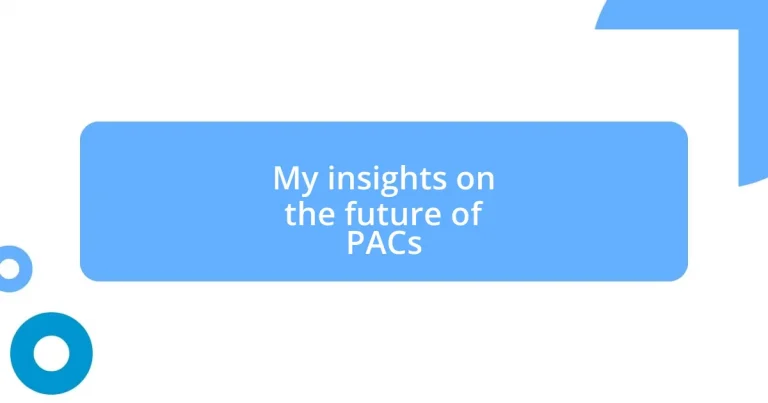Key takeaways:
- PACs play a crucial role in American politics by promoting specific issues and mobilizing communities, despite concerns about their influence on the political narrative.
- Current trends show a shift towards digital engagement, with PACs leveraging social media and data analytics to connect with younger audiences and streamline fundraising.
- Regulatory changes impose new transparency requirements that can hinder smaller PACs, pushing them to innovate in community fundraising and engagement efforts.
- Effective PAC engagement hinges on storytelling, interactive platforms, and soliciting feedback from supporters to foster participation and trust.
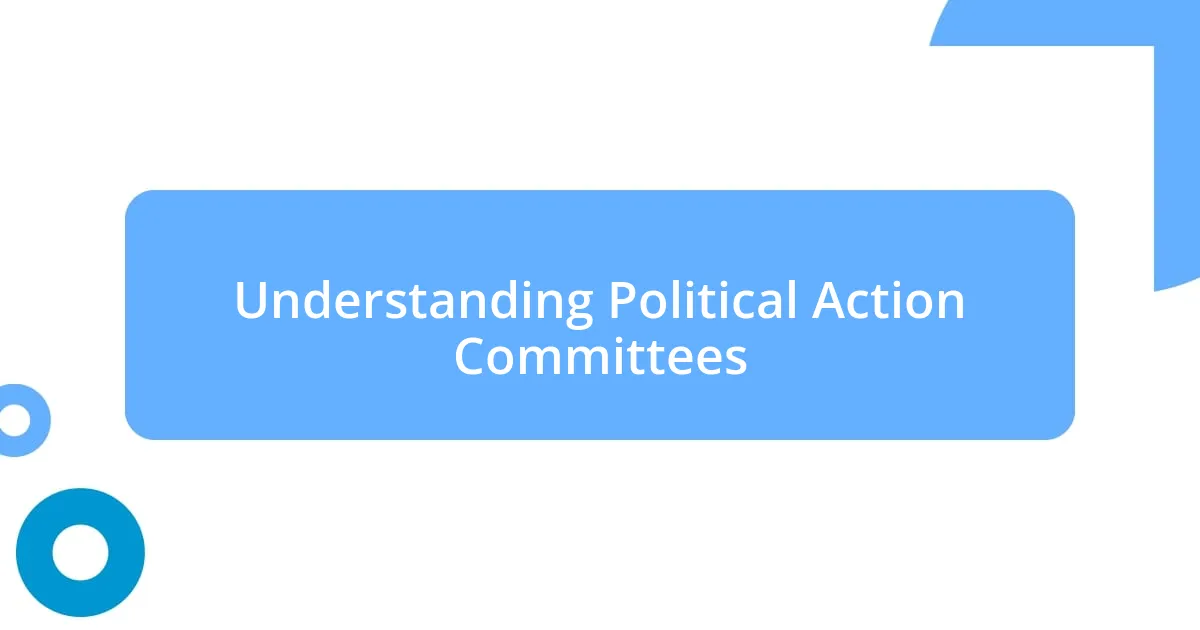
Understanding Political Action Committees
Political Action Committees, commonly known as PACs, play a pivotal role in the American political landscape. They are formed to raise and spend money to elect or defeat candidates, driven by shared interests, whether that’s environmental concerns, business interests, or social issues. I often wonder, what would political campaigning look like without these committees? They provide a powerful avenue for collective voices to amplify their impacts.
In my experience, I’ve seen how PACs can mobilize communities around specific issues. For instance, when I worked on a local campaign, a grassroots PAC organized volunteers who were passionate about education reform. Their determination and strategic funding made all the difference. It made me realize how critical these organizations are in shaping not only election outcomes but also policy discussions.
However, one must consider the implications of PAC influence. While they can promote essential issues, I often ponder whether this leads to a monopoly on ideas and funding. Are we allowing a select few to shape our political narrative? The dedication and resources of PACs certainly bring a mixture of hope and concern into the democratic process.
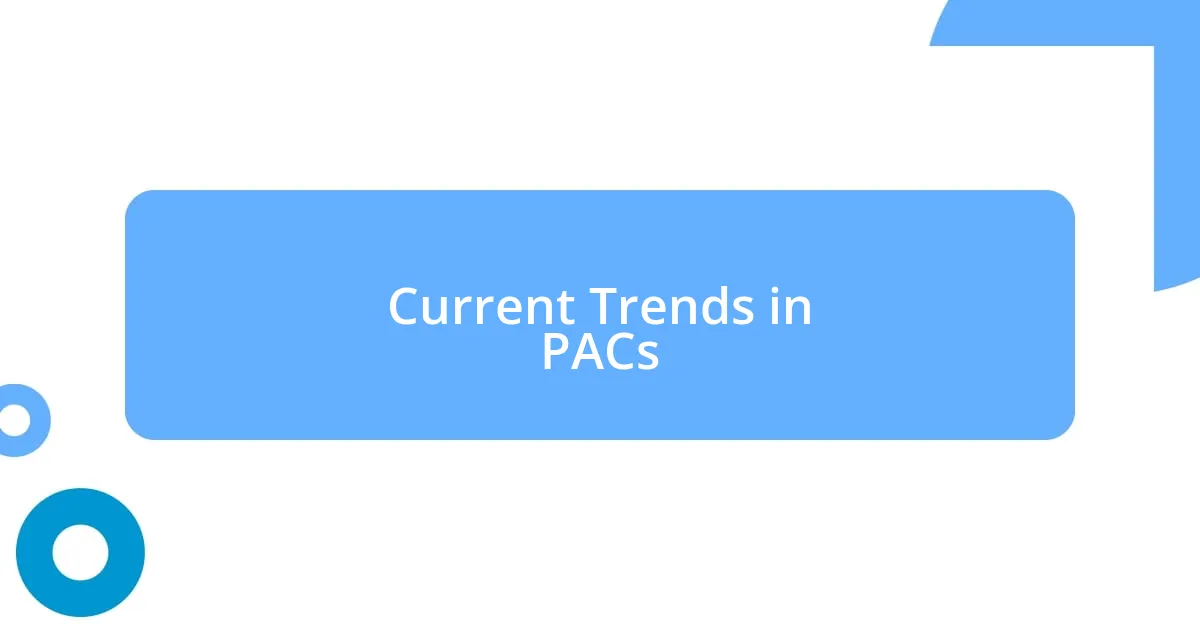
Current Trends in PACs
The current trends in PACs reveal a significant shift towards digital engagement and grassroots mobilization. I’ve noticed how PACs are increasingly leveraging social media platforms to connect with younger voters. This tactic not only raises awareness but fosters a sense of community among supporters. Last year, I attended a webinar hosted by a PAC focused on climate change, where they effectively used TikTok to galvanize support among Gen Z. The energy in the chat was electric, showcasing how technology can transform traditional lobbying methods.
Here are some key trends I’m observing in PACs:
- Digital Fundraising: More PACs are using online platforms to streamline donations.
- Targeted Messaging: A focus on specific demographics, especially Millennials and Gen Z, is becoming increasingly common.
- Collaborative Efforts: PACs are forming alliances with advocacy groups to broaden their reach and effectiveness.
- Data-Driven Strategies: Enhanced analytics are helping PACs identify potential supporters more efficiently.
It’s fascinating to see how these trends are reshaping the political landscape. At times, I find myself reflecting on my own experiences with campaigns, realizing just how critical adaptability is for these organizations in the modern age.
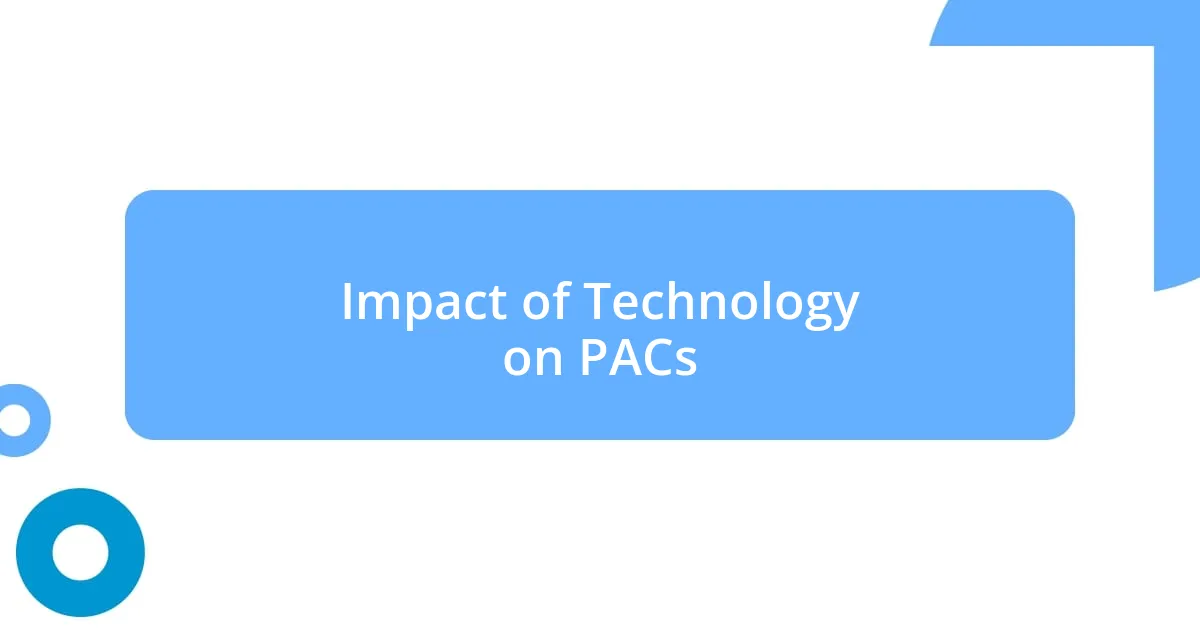
Impact of Technology on PACs
The advent of technology has ushered in a transformative era for Political Action Committees (PACs). From my perspective, the ability to harness data analytics is a game changer. Recently, I attended a conference where experts discussed how PACs utilize voter data to create targeted campaigns. This precision not only enhances engagement but also significantly boosts the chances of reaching undecided voters. I can’t help but marvel at how these tools empower PACs to fine-tune their messaging, ensuring that their voices resonate with the right audiences.
Moreover, the rise of social media has fundamentally altered communication strategies for PACs. I recall a time when I became involved with a PAC focused on social justice issues. Their unique approach on platforms like Instagram generated vibrant discussions around policy changes—far beyond what traditional media ever accomplished. This immediacy and accessibility give PACs the ability to engage younger demographics, fostering a sense of ownership and urgency around important causes. It’s genuinely exhilarating to witness these evolving dynamics in action.
Lastly, the integration of technology in fundraising processes can’t be understated. I experienced firsthand how a PAC I supported utilized crowdfunding strategies that allowed small donors to feel part of a larger movement. It was an emotional moment when our collective efforts led to a significant sum being raised in just a few hours online. This democratization of funding not only amplifies voices but also strengthens the belief that everyone can contribute to the political conversation, regardless of their financial resources.
| Impact Factor | Examples |
|---|---|
| Data Analytics | Targeted outreach and improved messaging techniques |
| Social Media Engagement | Mobilizing younger voters through platforms like TikTok and Instagram |
| Fundraising Innovations | Crowdfunding and online donation platforms |
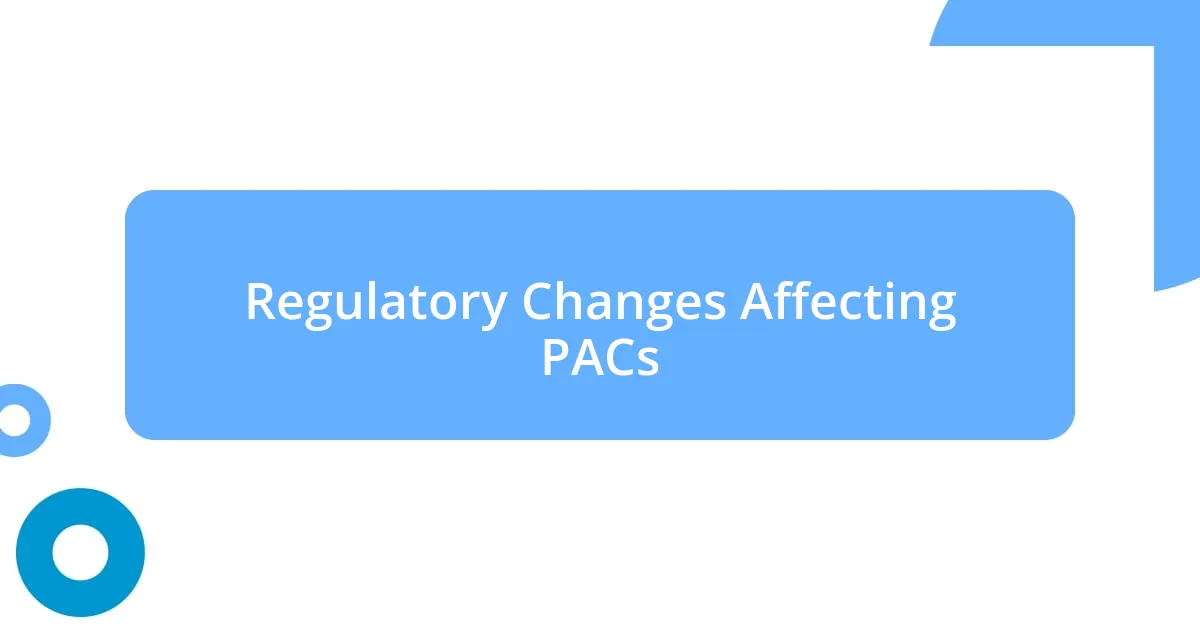
Regulatory Changes Affecting PACs
Regulatory changes are increasingly impacting how PACs operate, shaping their strategies in both fundraising and campaign outreach. Recently, I learned about new requirements mandating transparency in financial disclosures, which can feel like a double-edged sword. On one hand, it fosters trust; on the other, it complicates the already intricate web of compliance for organizations trying to navigate the political landscape.
I vividly remember discussing these challenges with a group of PAC leaders during a roundtable event. One member lamented how increased scrutiny had made it tougher for smaller PACs to compete. Isn’t it interesting how the rules meant to create a level playing field can sometimes tip the scales the other way? This reflection highlights the need for adaptability amidst evolving regulations that can significantly shift power dynamics in political fundraising.
Furthermore, the introduction of stricter limits on contributions from corporations has sparked a wave of creativity in how PACs seek support. I witnessed firsthand how a local PAC shifted its focus toward community-based fundraising events. The genuine connection fostered during these events not only raised essential funds but also nurtured a stronger bond among supporters. How many times have you seen a PAC thrive by engaging its base directly? In my experience, those connections can create lasting loyalty and a shared vision for change, underscoring the vital role regulations play in shaping PAC strategies.
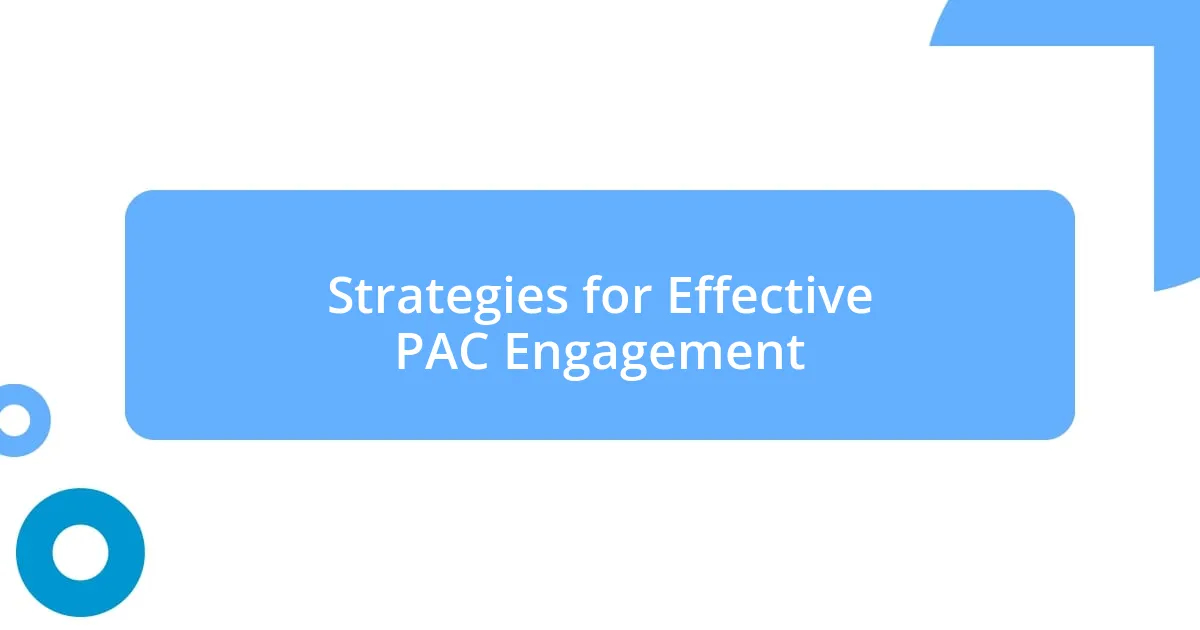
Strategies for Effective PAC Engagement
To foster effective engagement with PACs, I find that building a strong narrative is crucial. During a recent volunteer campaign, I saw how a compelling story about the PAC’s mission resonated deeply with supporters, drawing in young volunteers who were initially disengaged. It’s fascinating to consider how stories can bridge the gap between complex political issues and the personal experiences of individuals, making them feel seen and valued.
Additionally, leveraging interactive platforms can immensely enhance voter involvement. I remember a PAC that hosted a virtual town hall meeting where community members could ask questions in real-time. The buzz in the chat was electric! It reinforced my belief that direct interaction can transform passive audiences into active participants, fostering a sense of community and urgency around key issues. How often do we miss out on that valuable engagement simply because we rely too heavily on one-way communication?
Finally, embracing feedback from supporters can guide strategic decisions. In my experience, I noticed that a PAC I was part of regularly surveyed its members to understand their priorities and concerns. This practice not only made supporters feel valued but also provided insights that informed campaign strategies. Isn’t it remarkable how a seemingly simple act of asking for opinions can lead to more effective and engaging campaigns? Direct feedback not only sharpens focus but also builds trust, creating a robust cycle of engagement and action.
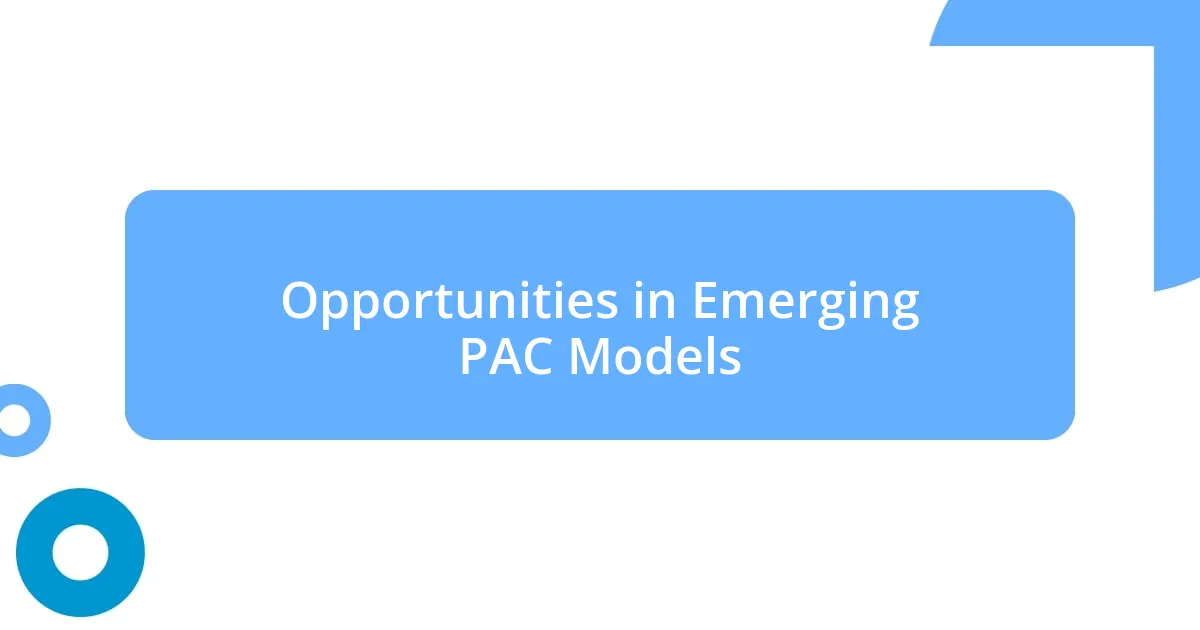
Opportunities in Emerging PAC Models
Emerging PAC models present exciting opportunities, especially when it comes to technology-driven engagement. I once attended a seminar where a forward-thinking PAC showcased how it utilized data analytics to tailor its outreach efforts. By understanding their audience’s preferences, they crafted personalized messages that resonated more deeply. It made me wonder: how often do we really tap into the power of data to enhance our connections? In the fast-paced political landscape, this approach can be a game changer.
Another promising avenue is the rise of issue-based PACs that align closely with specific causes, capturing the passion of stakeholders. I recall a passionate discussion with a friend who was newly involved in an environmental-focused PAC. Their enthusiasm was contagious, driven by the clear mission and community focus. Isn’t it incredible how aligning with a specific cause can invigorate supporters, attracting not just funds but also dedicated advocates eager to spread the word? This trend suggests that embracing clarity in purpose can lead to vibrant grassroots movements.
Moreover, partnerships with grassroots organizations are becoming increasingly valuable. I remember collaborating with a local nonprofit on a PAC initiative, and the sense of community we built was inspiring. It was clear that by combining resources and networks, we could amplify our impact. Have you ever experienced the power of collaboration? In my view, harnessing these partnerships can significantly extend a PAC’s reach while fostering a sense of unity among diverse groups. The need for collaboration has never been more essential.












